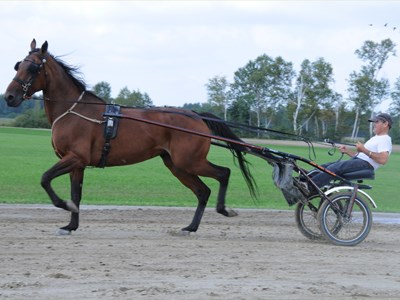Good ideas will have to become rapid realities if standardbred horses are to survive.
Developing life management programs for former race horses, moving them into post-sport or second careers, has long been a topic of discussion at Equine Canada (EC).
Vel Evans, an expert consultant at EC's industry division, said the organization is actively looking for markets to place the influx of horses coming off tracks across the province. While there is no exact number, the figure is in the tens of thousands. Estimates place the number of standardbreds at risk near the 30,000 mark.
In keeping with its mission of serving, promoting and protecting the interests of horses and Canada’s equestrian community, EC is working to evolve programs so more horses can find good homes. It certainly won't be an easy task.
Discussions of what comes next will undoubtedly be a big part of the organization's upcoming annual convention at the beginning of February, but that doesn't mean all the answers will be readily available.
“The situation in place in the Ontario racing industry is tragic and immediate,” Evans said. “There are no overnight solutions.”
Trouble presented itself March 12, 2012, when the Ontario Lottery Gaming Corporation announced proposals to modernize the gaming industry. This will happen via the elimination of the Slots at Racetracks revenue-sharing program effective March 31, 2013, which will take those funds away from racetracks and, as part of the larger picture, the horsemen who built their livelihoods upon the industry. Essentially, it means the province's race tracks likely won't be able to compete with the casinos being planned for the province.
EC has already identified some markets for the tens of thousands of standardbreds out of work. As competitive horseback riders age, they are looking for less physically demanding ways to stay involved with horses. Both competitive and recreational driving numbers are on the rise, and standardbreds are perfect candidates for this growing demographic, Evans said.
Of course, the option for retraining them as riding horses also exists. Lindsay Brunette promoted the breed as riding horses by hosting demos during the show season this past summer at local shows. The horse-lover aimed to raise the profile of the breed in an effort to dispel some common myths and misconceptions about them.
“A lot of people think they're hot-headed because they're race horses,” but this theory couldn't be further from the truth, Brunette said.
“(Standardbreds) see everything at the race track,” she said. “They're handled on a daily basis from a young age. They are exposed to everything and anything.”
From the time they're young, standardbreds are exposed to high-stress environments, regular brushing, trailering, blood work and other “spooky” things that aren't so common for riding horses.
As a result, they're “a dream to handle,” Brunette said.
While they can make for good riding horses, Evans said extra incentives could make former pacers and trotters more appealing prospects for riders. She said other breed organizations have developed programs to make former race horses more appealing to riders.
The Ontario Quarter Horse Association provides extra cash prizes to ex-race horses winning performance classes at sanctioned competitions, she said.
“The model exists,” Evans said.
It's something standardbred organizations can explore in the near future, she said.
“Things that have been talked about for a while ... will have to be put in place very quickly,” Evans said.
The option of exporting horses to other provinces and even other countries exists too. However, given that Ontario represents 80 per cent of Canada's racing industry, it's unlikely many standardbreds will find racing homes elsewhere.
“The rest of the country is not big enough to absorb them all,” Evans said.
The Ontario Standardbred Adoption Society is already feeling the strain of having too many horses and too few homes.
Anita TenBruggenchee, adoptions co-ordinator at the OSAS, said there are currently 34 standardbreds in foster homes through the organization. Typically, they like running around 25 horses in their care.
“We are all very worried,” she said. “It's a scary time for standardbreds right now. What the heck is going to happen to all these horses?”
Currently, the province's premiere adoption service provider receives a small percentage of purse money to help cover operational costs. While they only deal with “a drop in the bucket” of horses in the province, that ability will be limited with the end of racing.
“As they shut down, it will shut down that part of the funding,” TenBruggenchee said. Then it's back to raffles, golf tournaments and other fundraising efforts.
Currently, the society pays foster homes $10 a day to look after horses. From these private farms, they hope the animals will be adopted, for a small fee, into loving homes. Senior horses or ones who are unable to be ridden present even more of a challenge than horses who can be retrained for riding or driving.
“We're desperate to place them,” TenBruggenchee said.
While they're already busier than normal, things are going to get worse. TenBruggenchee said “there needs to be something more” done to help the influx of under-wanted horses coming off the track.
Funding for retirement home facilities is one option she suggested — certainly a better option than funding humane euthanization. As long as the horses are happy, sound and safe to handle, they should be allowed to live, TenBruggenchee said.
“It's a crime to have to euthanize them,” she said. While the organization doesn't support the idea of having horses put down, TenBruggenchee said it's a better option than letting horses suffer on their way to slaughter.
It's a common feeling among horse folks.
“All across the country, in all sectors of the horse industry ... there's been a lot of support for the racing industry in Ontario,” Evans said.
